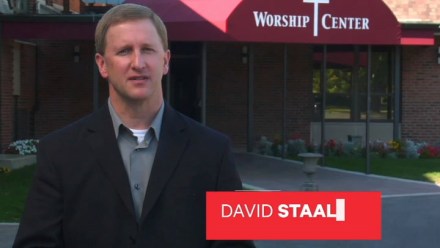Ministry can be a surprisingly hazardous profession.
Just ask Luke Trouten.
Back in 2010, Trouten, a youth pastor at Northwood Church in Maple Grove, Minnesota, was on a missions trip with junior high students when they decided to cool off at a local park.
Things went well till Trouten fell off a ledge and busted his leg.
“I ended up with some rods and screws and all kinds of things,” he said. “Didn’t walk for almost a year.”
Fortunately for Trouten, workers’ compensation covered all of his medical bills—including a couple of surgeries and a long hospital stay.
The process, at least as far as paperwork went, was fairly simple. The church’s office manager took care of contacting the insurance company. Once the company determined Trouten was working when he was injured, his bills were covered.
Accidents like Trouten’s aren’t that uncommon.
Staff and volunteers get hurt at church all the time, said Bill Mech, assistant vice president for health services and workers’ compensation at GuideOne Insurance, a company that specializes in insuring churches.
That’s in part because churches do a lot—from youth-group trips and kids programs to church work days and community concerts. And church staff can throw out their backs while picking up a box or volunteers can trip and fall, just like they do at any other workplace.
Then there’s the tendency for church staff and volunteers to do things themselves because finances are tight. So they may take a few more risks.
“There are a lot of times when a pastor gets up on a ladder and bad things happen,” Mech said.
Know your state’s rules
Workers’ compensation rules are set by each state. In many states—such as Illinois, Colorado, and Michigan—any organization with more than one staff person has to have workers’ compensation insurance. For the most part, churches are required to purchase it for their employees. A few states, like Texas, allow churches and other organizations to opt out of workers’ compensation. Also, most states draw a clear line between employees and volunteers, but a few, such as California, allow volunteers to be covered by workers’ compensation—more on this later. (To find workers’ compensation rules in each state, go to dol.gov.)
Still, there are advantages to having workers’ compensation insurance, even if it is not required, said Ryan Inzenga, an underwriting specialist for GuideOne.
“The injured worker can have their medical bills paid,” he said, “and the employer doesn’t have to worry about being sued.”
In general, the state laws that govern workers’ compensation prohibit employees from suing their employer if they are injured on the job, said Frank Sommerville, an attorney who specializes in legal issues facing churches and serves as an editorial advisor for Church Finance Today.
And churches are still responsible when an employee is injured, even if they don’t have workers’ compensation insurance.
“Even if a state allows churches to opt out, it’s probably not a good idea to do so,” said John A. Anthony, an attorney whose clients include churches, ministries, healthcare businesses, and physician practices. “Churches think if they do that, they are off the hook. But they are still responsible for what happens on their property and to their employees.”
Classify employees correctly
There are more than 600 classifications for employees. Not all position classifications are treated the same, either—roofers, for example, are more expensive to cover under workers’ compensation than office workers.
Sommerville said churches can run into trouble by misclassifying workers in order to save money on premiums. He knows of churches that classified maintenance staff as office workers, since it’s less expensive to insure them—only to be hit with thousands of dollars in penalties.
“That should not have happened in the first place,” he said.
Handling volunteers
Some states allow insurance companies to add an endorsement in their policies that includes volunteers.
GuideOne’s Inzenga and Mech are skeptical about that approach.
For one, volunteers aren’t really employees, they pointed out, and so trying to cover them through workers’ compensation is complicated.
Unlike employees, volunteers are not restricted to making workers’ compensation claims if they are injured, Sommerville said. So they may still sue a church, even if an endorsement is in place.
Further, if churches use an endorsement, said Inzenga and Mech, they would likely have to keep track of every volunteer, including logging each volunteer’s hours and duties performed. That’s because the price of workers’ compensation insurance is tied to the size of an organization’s payroll. And since volunteers aren’t paid, insurance carriers need to estimate the value of the labor done by volunteers.
“In some cases, the church could be facing a 50 percent increase in the cost of their coverage,” Mech said.
One alternative is to add an accident policy for volunteers, which would cover volunteers injured while working at the church, suggested the representatives of GuideOne.
Jeffrey Szalacinski, vice president of claims for Church Mutual Insurance Company, said a church’s general liability policy can cover volunteers, and churches can also purchase policies that specifically cover injuries to volunteers.
What about volunteer waivers?
Ron Smedley of California-based Employers Resource Associates believes that many churches have volunteers sign a waiver, agreeing to hold a church harmless if they get injured.
That approach may appear to be cost effective, he said, and some churches may feel they need to take that approach. But waivers can be challenged if someone is actually injured. And a waiver can create the perception that the church does not see their employees or volunteers as valuable.
In addition, as attorney Richard R. Hammar warns, waivers and releases often are viewed with disfavor by courts, and will not hold up when a situation involves gross negligence.
Pursuing prevention
Rather than leaning on some sort of waiver, Smedley believes churches should strive to provide some form of insurance for injured volunteers. Churches should also be proactive about preventing injuries in the first place.
Churches should designate someone to serve as volunteer coordinator and put together a volunteer handbook that includes safety rules and procedures. The handbook should also outline a plan for responding when an accident or injury happens. It’s a way to practice good stewardship, Smedley said, and to show care and concern for the well-being of volunteers.
The goal should be to prevent injuries—and to help people recover if they are injured, he said.
Having the right safety policies and insurance coverage helps create an environment that demonstrates the church’s messages that God loves and cares for his people, Smedley said.
Szalacinski also stressed that churches should be proactive with preventing injuries. An approaching big event or missions trip is a good time to go over a safety plan, he said. And insurance companies that work with churches publish guides for how churches can avoid or reduce risk.
Work closely with your agent
While churches need to be proactive about creating a safe environment for workers and volunteers, it’s very important that they also have the right insurance—just in case, Sommerville said.
“You are trying to keep your volunteers and your workers safe—but you also need the insurance in case bad things happen,” he stressed. “Because bad things can happen.”
In order to purchase the kind of insurance that’s best for your church, Sommerville said it’s crucial for a church to work closely with its insurance agent to audit its coverage. The more homework churches do, he said, the better price they’ll get.
Szalacinski recommended the same approach when exploring liability coverage for volunteers. And be sure to explain to your insurance agent all the different kinds of work that volunteers do at your church. The more your insurance agent understands about your church, the easier it will be to tailor a plan to meet your church’s needs and budget, he said.
Mech said most insurance companies have a minimum annual premium they charge, which can be as low as $500 to $1,000 for a smaller church. For a megachurch with many programs—such as a daycare, school, or camp—the premiums can reach six figures, he said.
If a church does have a workers’ compensation claim, their insurance may cost more. Mech said a claim in the vicinity of $5,000 can qualify for what’s known as an “eligibility rating,” and could cause rates to go up. It depends, in part, on the size of the church and how many claims are expected in a year.
If an employee or a volunteer gets hurt, it’s important to respond immediately and also take the injury seriously, Anthony said.
“You’d be shocked at how often someone says they’re fine when an accident happens at church,” Anthony said. “And then it turns out they were injured and need to file a workers’ compensation or liability claim.”
If someone gets hurt at church, make sure they get immediate assistance, Szalacinksi stressed, then report any injuries to your insurance company as soon as possible.
“The earlier those claims are reported, the quicker a claims representative can provide guidance to the church and to the injured worker or volunteer,” he said.
Court cases offer insights into who qualifies for workers’ comp
Three kinds of people generally work at churches, said Inzenga. There are employees, volunteers, and then independent contractors or “casual labor.”
Employees are paid staff, like pastors or office workers—those who generally qualify for workers’ compensation. Volunteers aren’t paid for their work—though they can be reimbursed for expenses or receive gifts, like meals, from the church. Then there are independent contractors—those who are hired to mow the lawns, fix the air conditioning, or do other tasks.
And what about a missionary? If a missionary speaks at a church and gets a “love offering” or other honorarium, they’re unlikely to be treated as an employee if they get hurt.
Things are more complicated if a church supports a missionary in the field. If a missionary is funded by the church—and isn’t employed by a mission board or other agency—then the missionary is likely an employee and needs to be covered by workers’ compensation.
Sometimes categories overlap. And that can cause headaches, confusion, and lawsuits—if someone gets injured.
A case out of Pennsylvania
A small congregation, the church relied on volunteer members to take care of maintenance. Among them was Edwin Halvorson, who joined the church in the late 1980s. As a volunteer trustee, he did a number of tasks—painting a bathroom, changing light bulbs, and vacuuming rugs. Eventually the church paid him to cut the lawn.
After mowing the lawn one day, Halverson also trimmed some bushes and decided to burn the leftover brush. He set them on fire, after dousing the brush with gasoline. The flames got too high and burned Halvorson. He died as a result of his injuries.
His family claimed he was an employee of the church—because he was paid to cut the lawn and used the church’s equipment—and filed a workers’ compensation claim. A workers’ claim tribunal agreed with the claim. The church appealed and in 2006, the Pennsylvania Supreme Court ruled that because Halvorson was serving in his role as a volunteer trustee, he was not eligible for workers’ compensation benefits.
A case out of Kansas
A similar case occurred in Kansas, after a group of church volunteers decided to cut down trees on church property. They brought their own chainsaws. One of the volunteers, the son of a board member, volunteered to haul away the wood from the trees with his pickup.
A week later, the church’s pastor asked the same volunteer to get rid of the stumps from the trees that had been cut down. Unfortunately, he cut his hand with the chainsaw while working on the stumps and ended up with $50,000 in medical bills.
So he filed a workers’ compensation claim, arguing that the church’s pastor had set the time and date the work on the stumps would be done and that his father and the pastor had supervised the job. In addition, he was allowed to keep the wood from the trees—which he claimed was a form of payment or compensation.
The courts ruled that the volunteer was an independent contractor—rather than an employee—and wasn’t eligible for workers’ compensation.
Insurance is a tool for ministry—helping a church or an injured worker or volunteer get back to where they were before an accident occurred.
Northwood Church’s Trouten is grateful his church had the right workers’ compensation insurance.
Four years after he broke his leg, he got hurt again, this time during a church clean-up day. He and other church staff and volunteers had piled up some brush to burn. Trouten went inside to get a lighter to set it on fire.
While he was gone, one of the other workers dumped gasoline on the brush but didn’t tell him.
When he leaned over to light the fire, there was a huge fireball—landing Trouten back in the hospital with burns over 20 percent of his body.
Fortunately the burns weren’t too severe and workers’ compensation insurance paid his medical bills.
He still helps out during the annual work day at church—though he steers clear of fire.
“I do have a great anecdote to use when I preach about hell,” he said.



















